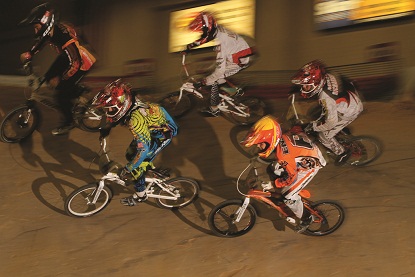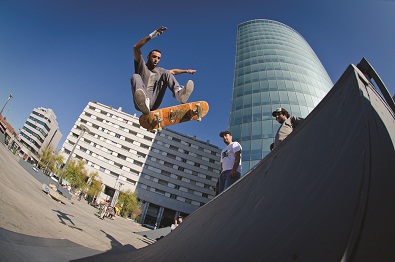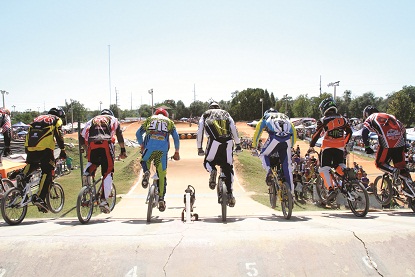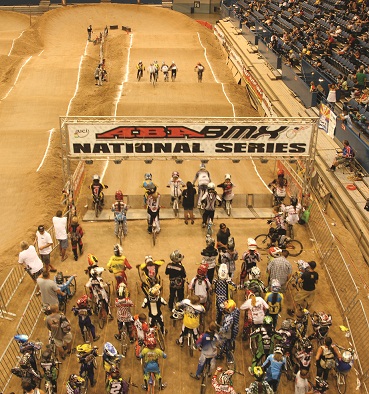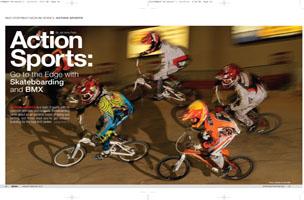
Action sports, extreme sports, x sports: whatever you call them, this is a class of sports with no concrete definition and no limits. Snowboarding came about as an extreme fusion of skiing and surfing, but these days you’ve got volcano boarding for the true thrill seeker.
|
Photo courtesy of USA BMX |
Extreme sports are certainly ever-changing and expanding, but there are some sports that will remain forever at the heart of the action. They are the action sports that started it all—skateboarding and BMX—and today, they are still extreme, but they are also everywhere.
Sidewalk Surfin’
Invented in the 1950s, the skateboard—originally with metal wheels—was popularized in the 1960s by the Jan and Dean song “Sidewalk Surfin’.” In the 1970s, new urethane wheels and fiberglass boards opened up a whole new world of techniques, and skateboarding as we know it today began to emerge.
The skateboarding 'pool' also emerged in the ‘70s when a California drought drained hundreds of suburban pools, opening up an unconquered landscape for the state’s skateboarders. Concrete skateparks also began to appear, and an American phenomenon began, one that would be cemented with the inception of the X Games in 1995.
A fringe sport for years, skateboarding has made a definite move to the mainstream in recent decades, a move that can be mapped as skateparks popped up prodigiously along both coasts and then moved into middle America.
|
Homydesign/Dreamstime.com |
Why the huge boost? It’s pretty simple: kids like to skate. Add to that the grown-ups who liked to skate in their youth and still want to skate, and you’ve got quite a demand for skateparks. According to the Tony Hawk Foundation, America has 9.3 million skateboarders, but only about 3,000 skateparks, putting thousands of skateboarders on the streets. That’s tragedy waiting to happen, says the foundation, because 90% of American skateboarding deaths occur outside of skateparks. After that, the math is easy. America’s communities need skateparks.
Many communities are already on board, with new parks opening all the time. Victoria, Texas, built and opened its first, Victoria Skate Park, just a few years ago.
“The way it happened was that we had a bunch of people who wanted a park, so we got everyone together in a kind of town hall meeting and got started,” says Shane Simon, recreation services manager, Victoria Parks & Recreation. The city hired SPA Skateparks, a Texas-based design/build contractor that specializes in skateparks, and they began work in August 2008. In December 2008, Victoria Skatepark welcomed its first skaters. Victoria Skatepark has a plaza-influenced street course and a bowl with four different depths, as well as walkways connecting both courses.
In Odessa, Texas, the newest skatepark is named for 16-year-old Ruben Pier, a local sixteen-year-old who was killed by a car while skateboarding along a street. Ruben Pier Memorial Skatepark, welcomed enthusiastically by Odessa’s skateboarders in 2009, is an 11,000-square-foot park with a street course as well as a seven-foot-deep bowl.
“Locally, it’s a great thing,” says Jeff Meyers, sport sales specialist, Odessa CVB. “The city has done a great thing, giving the kids somewhere to go and do their thing safely.”
While many communities are getting on board, there’s still a long way to go to meet the demand. For communities who are hoping to build or add another skatepark, it’s time to meet Heidi Lemmon. Lemmon is the executive director of the Skate Park Association of the United States of America (SPAUSA), which provides communities the information and resources they need to make skateparks a reality.
“The good news is that new parks are going in all over, and all the time parks are getting better,” says Lemmon. “If there’s one thing I’d like to see more of, it’s people building better. You’ve got to hire designers and builders who know skateparks. A lot of cities use their own architects, who come up with designs that look good on paper, and they might even be good to look at, but can you skate it? It takes skating experience to really know that.”
California Skateparks, a contractor that handles every aspect of skatepark creation, lives that philosophy by employing experienced skateboarders to oversee every project. The company has just won the job of building a 40,000-square-foot, $1.2 million skatepark in Swift-Cantrell Park in Kennesaw, Georgia. California-based Site Design Group will design the park.
In some cases, cities have taken the experience angle even further. Oklahoma City, for example, called in a pro.
In 1987 Mat Hoffman was 15 and the youngest rider joining the freestyle BMX circuit. Known as a rider who redefined his sport, Hoffman brought the action home to Oklahoma City in 2005, when he helped design and open the Mat Hoffman Action Sports Park. The park features a flow course with bowl combinations of varying shapes, depths and heights, including an 11-foot half pipe, which is connected to the street course by an obstacle-laden 20-foot-wide sidewalk. In 2009, National Geographic called the park one of the ten best skateparks in the nation in its "The 10 Best of Everything Families: An Ultimate Guide for Travelers.”
More than just a skatepark, Mat Hoffman Action Sports Park is shared by BMX riders and skateboarders. This is a controversial issue in many skateparks, but according to Lemmon, sharing need not create any issues.
“BMX and skateboarders use the same park in every country in the world except in the U.S.,” says Lemmon. “Some people think the BMX bikes tear up the course, but I’ve never seen evidence that they do. I’d really recommend that people planning a skatepark talk to people in communities where BMX and skateboards share the park. I think they will be surprised at how few, if any, problems there are and will be overwhelmed by the benefits.”
|
Photo courtesy of USA BMX |
Riding the Excitement
BMX was born in the ‘70s when some California kids modified their bikes to race motocross-style. Fueled by the era’s motocross madness, BMX exploded immediately, and the sport developed several styles. One style, BMX racing, became an Olympic sport in 2008. BMX racing is performed on a dirt track, either indoor or outdoor depending on the season, with jumps, tight corners and turnarounds. Another common type is freestyle BMX, which, much like skateboarding, comes in its own variety of disciplines, including street, dirt, vert, downhill and park (as in skatepark).
John David is chief operating officer of USA BMX, the national governing body (NGB) for BMX racing.
“Our sport has made amazing progress over the past six years. Despite tough economic times, our numbers are on a steady increase,” says David. “We attribute this to the Olympics, and heading into the 2012 London games, we’re seeing a lot of positive feedback that’s helping the sport grow.”
For almost 40 years there have been two NGBs in BMX racing, says David, the American Bicycle Association (ABA) and the National Bicycle League (NBL), but in the summer of 2011 the two organizations joined forces, becoming USA BMX. With the combined memberships of both organizations, USA BMX is extremely well-represented across America.
With a newly unified NGB, in 2012 BMX racing will have one schedule of national events for the first time in decades, and USA BMX will be visiting some of the country’s best courses. “South Park BMX [Pittsburgh, Pennsylvania] used to have a lot of pro racing, and we’re going to bring it back,” says David. “We’re also visiting Pottstown [Trilogy Park BMX], and that’s going to be a great event.”
|
Photo courtesy of USA BMX |
BMX also has a long and distinguished history in Oklahoma. ABA held its Grand Nationals in Oklahoma City for many years until the event outgrew its facility, the Myriad Convention Center (now called the Cox Convention Center).
“The facility in Oklahoma City was great for us, but when we outgrew it, we found a wonderful home in Tulsa,” says David. “We’ve got a fantastic partnership with the Tulsa Sports Commission and the CVB, and the town literally embraces us. Everywhere you go, everyone knows about the event and is excited about it.”
Tulsa’s 448,000-square-foot Quiktrip Center, one of the largest clearspan buildings in the world, hosted the ABA Grand Nationals in 2011.
When visiting venues that aren’t purpose-built BMX facilities, the USA BMX staff constructs its own courses. “We’ve got an outstanding team of track designers. Sometimes the hardest thing to do is tear down a track when an event is over,” says David.
David has a few favorite permanent BMX facilities, too, like Derby City in Louisville, Kentucky. “They’ve got a phenomenal facility, right in E.P. ‘Tom’ Sawyer State Park, and they hosted the NBL Grand Nationals.”
Last July the ABA visited another exceptional facility, Burlington BMX in Alamance County, North Carolina, for the Tarheel Nationals.
“We have a great track here, an outdoor facility within Fairchild Community Center,” says Robert Cox, vice president, Burlington/Alamance County Convention & Visitors Bureau. “It also has a very well-run parents' organization that handles everything from organization, promotions, concessions—anything you can imagine—along with the help of Burlington Recreation and Parks.”
But no matter where BMX racing events take place, says David, “one of the most special things about our sport is the demographics. When we come to a community and host a major national event, we bring racers in, some as young as three years old and some in their 70s. It’s a sport of all ages and a sport of families. Sometimes entire families – mom, dad, kids and even grandparents – all race together.”
|
Photo courtesy of USA BMX |
Now an Olympic sport, BMX racing has a new event in its schedule: Olympic trials. Those are held at the Chula Vista Olympic Training Center just outside San Diego.
“We’re very excited to be the home for the upcoming Olympic trials,” says Steve Schell, vice president of sales, San Diego Sports Commission. “The Olympic Training Center has a world-class BMX track, and we do a number of events there. This fall we hosted the Supercross World Cup, and it was fantastic. We had 3,500 daily attendance over two days, and the event itself produced 2,671 room nights.”
As the home of pro skateboarding greats like Tony Hawk as well as one of the country’s most prominent BMX tracks, San Diego could make a claim as the epicenter of America’s action sports world. Perhaps that’s why the world’s only board triathlon – Ultimate Boarder – also calls the city home. (Snowboarding takes place in nearby Big Bear, then the event moves to San Diego for surfing and skateboarding).
“We’re really proud of being the home of Ultimate Boarder,” says Schell. “2012 will be its fifth year, and founder Tim Hoover is setting up the next event with athletes and partners to make the fifth year the springboard that puts this on everybody’s calendar and mind.”
The $100,000 purse—the highest award for any skateboard or snowboarding event—will probably create some buzz as well. It’s a remarkable prize that’s enough to prove that action sports have captured the hearts of America, as well as the dollars of sponsors.

